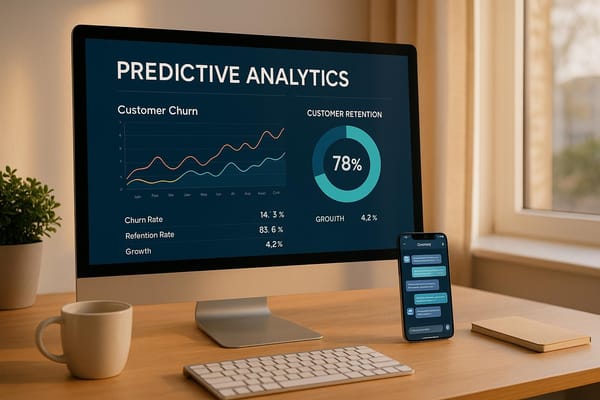How Real-Time Analytics Can Transform Your Customer Support Strategy
Transform your customer support with real-time analytics to enhance speed, personalization, and proactive issue resolution.

Want to improve customer support? Real-time analytics is the answer.
It helps businesses respond faster, personalize interactions, and solve problems before they escalate. Here's how it works:
- Instant Insights: Analyze customer data as it happens, unlike delayed traditional analytics.
- Better Customer Experience: Reduce wait times, tailor support, and prevent issues early.
- Key Metrics: Track response times, resolution rates, and customer satisfaction in real time.
- Affordable for SMBs: Tools like HelpJam make advanced analytics accessible, starting at $49/month.
Quick Comparison of Traditional vs. Real-Time Analytics:
| Factor | Traditional Analytics | Real-Time Analytics |
|---|---|---|
| Data Speed | Delayed batch processing | Live, immediate insights |
| Data Type | Structured (e.g., forms, databases) | Structured + unstructured (e.g., chats, voice) |
| Insights | Manual interpretation | Automated trend and sentiment detection |
| Personalization | Generalized | Tailored to individual behavior |
Real-time analytics is transforming customer support into a proactive, efficient, and customer-focused process. Keep reading to learn how to set up systems like HelpJam and track key metrics to boost satisfaction and retention.
Building a Real-Time Analytics System with HelpJam

Creating a real-time analytics system doesn’t have to be overwhelming. HelpJam simplifies the process, equipping your customer support team with the tools they need to deliver top-notch service. Here's how to get started.
Setting Up HelpJam's Real-Time Dashboard
HelpJam’s dashboard offers immediate visibility into customer interactions and team performance. You can start with the basics and expand as your needs grow.
First, log in to your HelpJam workspace and head to the analytics section. The setup focuses on three key areas: conversation monitoring, resolution tracking, and response time analysis. These real-time insights provide a live view into your support operations, helping you stay on top of customer needs.
For added value, configure sentiment tracking alerts. These alerts notify supervisors when the platform detects negative tones in customer messages, ensuring urgent cases are flagged before they escalate. Similarly, you can set up alerts for potential SLA breaches, giving managers a chance to redistribute workloads and avoid delays.
HelpJam also lets you monitor website performance in real time. Track metrics like page load times and server response times to ensure your knowledge base and chat widgets are working smoothly for self-service users.
Once your dashboard is up and running, customize the metrics to align with your business goals.
Adjusting Metrics for Your Business Goals
Every business is different, so your analytics should reflect what matters most to your customers and your team. HelpJam provides eight core metrics to guide your support operations:
| Metric | Definition | Business Impact |
|---|---|---|
| First Response Time (FRT) | Time from ticket creation to the first agent reply | Impacts customer satisfaction and perceived responsiveness |
| Time to Resolution | Total time from ticket creation to resolution | Measures support team efficiency and customer effort |
| Customer Satisfaction (CSAT) | Percentage of positive survey responses post-interaction | Indicates service quality and customer experience |
| Support Volume | Number of tickets handled | Helps with staffing and identifying peak periods |
| Ticket Deflection Rate | Percentage of users solving issues without agent help | Reduces costs and boosts scalability |
| First Contact Resolution (FCR) | Percentage of issues resolved on first contact | Shows team efficiency and knowledge base effectiveness |
| Team Workload Distribution | Active tickets per agent | Prevents burnout and ensures consistent service levels |
| Customer Message Sentiment | AI analysis of customer tone in messages | Flags urgent cases and avoids escalations |
These metrics help you make data-driven decisions for daily operations. For example, you can set up custom alerts for specific events, like traffic surges or drops in conversion rates. If customer experience metrics like CSAT or NPS start trending downward, compare related metrics - such as resolution times or contact rates - to identify problem areas.
Adding Real-Time Analytics to Daily Work
Once your metrics are customized, the next step is integrating these insights into your team’s daily routine for continuous improvement.
Start by reviewing your current capabilities and identifying areas that would benefit most from real-time insights. Tailor dashboards to highlight essential metrics - such as agent performance, sentiment analysis, and call duration - so both agents and supervisors have the visibility they need.
Training plays a crucial role in adoption. Equip your team with the skills to use analytics effectively, ensuring they can make real-time adjustments instead of waiting for periodic reviews.
Analytics also provides immediate feedback, helping agents fine-tune their approach throughout the day. By focusing on critical metrics and leveraging HelpJam’s advanced tools, you can optimize operations and improve decision-making.
Take Jenzabar’s support team as an example. They implemented analytics-driven automation, including automatic case assignments, intelligent routing, and escalation management. This significantly boosted their efficiency.
"Supportbench automates so many of our processes, from case assignments to escalations. This means our agents can focus on solving problems rather than managing logistics."
– Michael Floyd, Director of Customer Support, Jenzabar
Using Real-Time Data to Better Serve Customers
Real-time analytics has reshaped customer support, turning it into a proactive approach. By identifying potential issues early and acting swiftly, businesses can enhance customer satisfaction while keeping costs in check. But the benefits don’t stop there - real-time data also shortens response times and improves personalization.
Cutting Response and Resolution Times
When it comes to speed, real-time monitoring is a game-changer. It removes the guesswork from traditional support processes, enabling faster responses and quicker resolutions.
Take HelpJam’s dashboard, for example. It highlights workflow bottlenecks, tracks response times across channels, and monitors agent workloads. This clear visibility allows supervisors to step in, redistribute cases, or assist overloaded agents when necessary. The result? A smoother workflow and happier customers.
The numbers speak for themselves. Businesses that incorporate real-time data into their decisions can see up to a 20% boost in efficiency, while those leveraging advanced analytics tools have reported increases as high as 60% in operational efficiency.
Call routing is another area where real-time analytics shines. Instead of sending customers on a frustrating journey between departments, intelligent routing systems use live data to connect them with the right agent immediately. CHG Healthcare illustrates this perfectly. By analyzing call traffic with Invoca, they discovered a mismatch in call handling - one division answered less than 20% of calls, while another handled 70%. The culprit? Calls were being routed to voicemail instead of live agents. Fixing this issue led to a 50% improvement in connection rates and boosted conversion rates significantly.
Beyond call routing, real-time analytics monitors key metrics like order accuracy and delivery times. This allows businesses to make quick adjustments, reducing customer frustration and laying the groundwork for more personalized experiences.
Customizing Customer Interactions
Building on faster resolutions, real-time data takes customer interactions to the next level by enabling deep personalization. When someone contacts support, agents can instantly access details like recent activities, purchase history, and even the customer’s current mood. This eliminates the need for repetitive explanations and helps agents tailor their responses effectively.
Personalization isn’t just a nice-to-have - it’s a revenue driver. Companies excelling in this area generate 40% more revenue than their competitors. And it’s what customers want: 71% say personalized communication influences their brand choices, and tailored experiences can deliver five to eight times the return on marketing spend.
HelpJam’s sentiment tracking is a great example. Using AI, it analyzes customer messages in real time, helping agents gauge emotional context. If frustration is detected, agents can prioritize empathy. On the flip side, positive interactions open opportunities for upselling.
The impact of real-time personalization is evident in success stories. Yves Rocher saw an 11x increase in purchase rates with personalized product recommendations. Similarly, The Thinking Traveller boosted booking inquiries by 33%, and TFG’s fashion retail platform saw a 35.2% jump in online conversion rates and a 39.8% increase in revenue per visit during Black Friday sales. When combined with early issue detection, personalization becomes part of a comprehensive data-driven support strategy.
Finding and Fixing Issues Early
Real-time analytics doesn’t just solve problems - it prevents them. By analyzing patterns in customer behavior and system performance, businesses can identify potential issues before they escalate.
For example, if multiple customers report similar issues within a short period, the system can flag the pattern and alert the team. This proactive approach stops small problems from snowballing into bigger ones.
One ICT services provider demonstrated the power of this strategy by using an AI-driven interaction analytics platform. In just six months, they achieved a 42% improvement in First-Call Resolution (FCR), a 25% drop in repeat calls, and a 20% reduction in customer effort scores. They also saw a 15% decrease in Average Handle Time and a 20% boost in customer-rated Quality of Service.
"With AI's help, real-time data analytics transforms customer interactions by enabling businesses to respond faster, optimize operations, and enhance service quality."
- Abhinandan Jain, Chief Growth Officer at Startek
Predictive models can also uncover recurring issues. For instance, if a specific feature consistently leads to support calls, businesses can proactively address the root cause - whether by improving the feature or creating targeted help content.
DoorDash is a great example of this proactive approach. After noticing a drop in NPS scores due to frustrations with their Merchant Menu Manager, they revamped the interface. The result? Menu update times dropped from 11 seconds to under 3 seconds, dramatically improving merchant satisfaction.
To keep predictive analytics effective, continuous monitoring is essential. As customer behavior and business conditions evolve, models need regular updates. Research suggests that predictive analytics could influence up to 25% of service interactions by 2025, making early adoption a key advantage.
"Predictive analytics enables businesses to go beyond reactive problem-solving by delivering proactive, tailored support."
Tracking Success: Key Metrics and Best Methods
To truly understand your support team’s performance, it’s crucial to focus on metrics that tie directly to customer satisfaction and overall business goals. Below, we break down the most important support metrics, explore comparison reports, and explain predictive methods that can lead to actionable insights.
Important Metrics for Customer Support Teams
Support metrics serve as a health check for your strategy. By combining quantitative data with qualitative insights, you can get a fuller picture of performance.
First Contact Resolution (FCR) is one of the most telling metrics. Resolving customer issues on the first interaction not only boosts satisfaction but also lowers costs. Tracking FCR in real time helps identify recurring issues and address root causes before they escalate.
Average Resolution Time (ART) focuses on how quickly problems are fully resolved, as opposed to just measuring call duration like Average Handle Time does. Monitoring ART in real time can highlight bottlenecks, enabling targeted training or process improvements.
Customer Satisfaction Score (CSAT) offers immediate feedback on the quality of service. Real-time sentiment tracking can even predict CSAT, allowing agents to adjust their approach on the fly. This matters because 77% of consumers say that valuing their time is the most important factor in a great customer experience.
Customer Effort Score (CES) measures how easy it is for customers to get the help they need. Identifying friction points in real time can prevent customer loss, especially since one-third of consumers are willing to switch companies after just one bad service experience.
The Net Promoter Score (NPS) evaluates customer loyalty, complementing CSAT by focusing on long-term relationships.
Self-Service Success Rate is increasingly important as more customers prefer solving problems on their own. Tracking which knowledge base articles are used most - and where customers abandon self-service attempts - can reveal gaps and opportunities for improvement.
Building Comparison Reports with HelpJam
While individual metrics are valuable, comparing data across different dimensions often reveals deeper insights. HelpJam’s analytics dashboard turns raw data into meaningful trends, offering real-time comparison reports that eliminate the need to wait for end-of-month summaries.
Time-based comparisons help you track how metrics change over specific periods. For example, if FCR rates dip at certain times, it could point to staffing issues, specific problem types, or even system glitches. HelpJam’s tools automatically highlight these trends, saving you from manual analysis.
Agent performance comparisons spotlight top performers and those who may need additional support. These reports aren’t about fostering competition - they’re about identifying best practices. For example, if one agent consistently earns high CSAT scores, their methods can be shared with the team.
Channel comparison reports show how performance varies across email, chat, phone, and social media. This insight allows you to allocate resources more effectively. If one channel consistently resolves issues faster, you can prioritize it during busy times.
Issue category analysis identifies which problems consume the most resources and which are resolved efficiently. HelpJam’s AI automatically categorizes tickets, so you can quickly adjust staffing or update self-service tools when certain issues spike.
The predictive trending feature uses historical data to forecast future performance, helping you prepare for surges in demand with proactive staffing adjustments.
Planning Resource Use with Predictive Data
Predictive analytics shifts resource planning from reactive guesswork to proactive preparation. By analyzing customer behavior patterns, seasonal trends, and business cycles, teams can allocate resources effectively and maintain consistent service quality.
Demand forecasting predicts when support volume will rise. HelpJam’s models analyze historical data to spot trends - like increased tickets after marketing campaigns or during product launches - so managers can schedule extra staff or set up automated responses in advance.
Skill-based routing optimization ensures customers are matched with the right agent from the start. For instance, if certain agents excel at technical issues while others handle billing questions better, predictive routing can reduce transfer rates and improve first-contact resolution.
Proactive issue identification helps catch problems before they escalate. As Lumenalta notes:
"Predictive analytics enables businesses to go beyond reactive problem-solving by delivering proactive, tailored support".
Staff training prioritization becomes more effective when predictive models identify skill gaps. If data suggests an upcoming need for specific expertise, training programs can be launched ahead of time to prepare agents.
Budget planning also benefits from predictive insights, as understanding seasonal trends and growth patterns enables more accurate financial planning for support operations.
To make predictive analytics work, clear goals are essential - whether it’s reducing customer churn or improving response times. Investing in high-quality data and scalable, cloud-based platforms for real-time processing is equally important. Training staff to interpret analytics and regularly monitoring model performance ensures that insights remain actionable as business conditions evolve.
The potential impact is enormous. In 2024, Visa used an AI model to analyze 500 attributes per transaction, saving $40 billion in fraud detection - more than double what they achieved without AI. While customer support operates on a smaller scale, the principles of proactive, data-driven planning can still create transformative results. By leveraging these insights, your support team can stay ahead of the curve, making real-time analytics a cornerstone of exceptional customer service.
Conclusion: Improving Support with Real-Time Analytics
Real-time analytics has the power to turn customer support into a key driver of growth. Companies leveraging data-driven strategies are seeing tangible results. Take the example of an ICT services provider: by implementing an AI-powered interaction analytics platform, they achieved a 42% boost in First-Call Resolution, cut repeat calls by 25%, and saw a 20% jump in customer-rated Quality of Service - all within just six months.
To replicate such success, it’s crucial to set clear goals, whether that’s increasing customer retention or streamlining operational processes. HelpJam’s real-time analytics dashboard can be the foundation for these efforts. You can get started with their free plan and, as your needs grow, upgrade to the Starter plan for $49/month.
The next step is turning insights into action. With HelpJam, automated data collection simplifies tracking metrics like Customer Acquisition Cost, Customer Lifetime Value, and engagement rates. Sentiment analysis tools make it easier to adapt on the fly, ensuring your team delivers consistently high-quality support.
Here’s why this matters: 86% of consumers evaluate companies based on their service, and a third will leave after just one bad experience. Additionally, 60% of customers worldwide expect seamless transitions between service channels, making real-time analytics not just an advantage but a necessity.
The tools are in place, the results speak for themselves, and the opportunity is clear. By integrating HelpJam’s real-time analytics, you can transform customer support from a cost center into a competitive edge. Empower your team to move beyond reactive problem-solving and deliver proactive, exceptional service.
FAQs
How can real-time analytics make customer support more personalized?
Real-time analytics transforms customer support by equipping agents with instant access to the latest customer data. This means agents can adjust their responses based on the customer's current behavior, preferences, and needs, delivering solutions that feel more relevant and on-point.
Beyond just reacting, real-time insights let businesses spot potential problems before they escalate. Addressing these issues early creates a smoother experience for customers and adds a personal touch that strengthens trust and loyalty over time.
How does real-time analytics differ from traditional analytics in customer support?
Real-time analytics works by processing data the moment it’s generated, delivering immediate insights that allow for quick decisions and proactive customer support. On the other hand, traditional analytics relies on historical data, which often means insights come with a delay, leading to reactive strategies.
With real-time analytics, businesses can tailor interactions on the spot and resolve customer issues right away, improving satisfaction and engagement. While traditional analytics is valuable for identifying long-term trends, it typically results in slower responses and less personalized solutions. Using real-time data, companies can streamline operations and elevate the customer experience simultaneously.
How can small businesses use real-time analytics without straining their resources?
Small businesses can make the most of real-time analytics by taking a step-by-step approach. Start by focusing on a few key metrics that are directly tied to your business goals - things like customer satisfaction or response times. This way, you can avoid drowning in too much data and keep the process manageable as you introduce analytics tools.
Look for platforms that are easy to use and don’t demand advanced technical skills. Many tools are designed with beginners in mind, offering built-in tutorials and support to help teams without data specialists get up to speed quickly.
It’s also worth investing in training your team to understand the data and use it to make smarter decisions. By encouraging a data-focused mindset, even small businesses with limited budgets can enhance customer experiences, simplify operations, and fuel growth - all without feeling overwhelmed.





